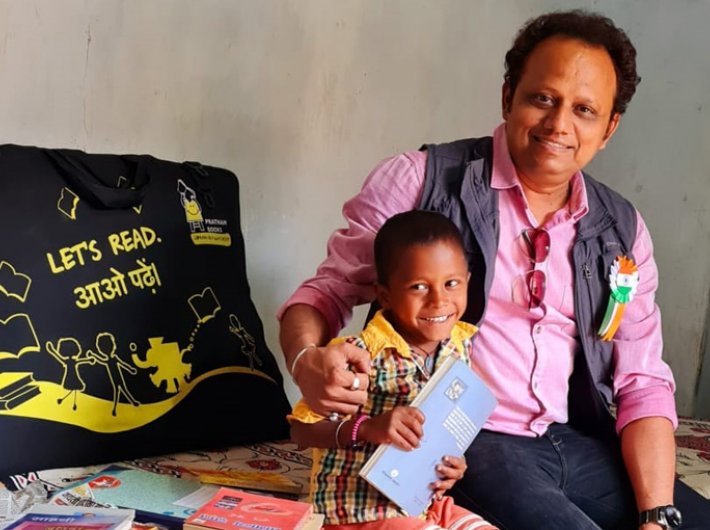Interview with Shubhasish Chakraborty: “Let us co-create a culture of Individual Social Responsibility”
Shubhasish Chakraborty has been working for the upliftment of tribal areas of India. He wears several hats while discharging his duties as a general manager in a global conglomerate apart from being an expert on tribal affairs who works tirelessly in the field of community development. He is an award-winning filmmaker, poet and short story writer. He is trying to bring tribal art, culture and talent to the international stage and through such recognition and aiming to improve the livelihood of tribal people. In an interview with Praggya Guptaa, he talks about is vision:
How did the idea come to you to work for the tribals in Jharkhand?
Growing up in the state of Jharkhand has always created opportunities for me to love the tribal community. I have minutely watched their festivals and rituals and was mesmerized by their ‘always happy gesture’. These are the people whose spirits have remained untouched by worldly desires. They are painters, they are singers, they are musicians; they are simple people simply doing great things. They are free from futuristic mania, which has made people insensitive to the subtlety of moments.
I was always inspired by the tribal friends who believe in the existence of ‘now’; who believe in living in ‘now’; who yearn to live it again. Their quest has made me travel through seasons, colours, poems, songs, stories, hope, despair, noise, silence, darkness, and light. And yet there has been only one longing: when will ‘now’ come in the vicinity of senses, for rest of us.
What do you do for the upliftment of tribal people in the region?
The worldview and inclusive thinking of tribal people have always attracted me to know them more. I remember that from the early years of my life when I was just around 17-18 years old, I developed a passion of recording their oral literature (stories, legends, folklores, idioms, etc.) from people of different age groups to notice that what fold the narrative takes in different mouths. I was always passionate to find what affects the literature of these lesser-known oral languages and of course the possible ways to present/ revive the idea of contemporaneity.
My love and fascination for rural culture and tribal life began at a young age, but I got an opportunity to explore it for myself in 2011 while working with Tata Steel in Jharkhand.
I have been donating my salary for over 10 years in helping and transforming the underprivileged communities in Jharkhand. I also worked for their well-being and provided them platforms to exhibit their talent.
Since Jharkhand is understood and known to be home to the numerous tribal groups like Munda, Santhal, Ho and Oraon, I will not leave a single weekend to go and meet and interact with them. I observed their indigenous practices, lifestyle, and traditions. As days and weeks gone by, I also observed that the efforts they put in to showcase and express their vibrancy through art and craft gets minimal recognition. That was once I decided to try my bit to create a platform for them to exhibit their talent.
I have sponsored and curated the first and primary exhibition for tribal painters in Jamshedpur, Jharkhand in 2010. This fascination for art and culture then found an outlet in cinema. As a teenager, I was introduced to the wonderful world of art and music. I even had formal music training andhave dabbled in painting and sculpture. I was always inclined to cinema. I feel it is a medium that provides an immense depth of expression. While travelling within the tribal heartland, I felt that cinema is the apt medium for capturing the tales of the gorgeous land and its people. I took up the camera to capture this poetry and music in film. Thus enthused, I even have made two short films on two different aspects of tribal life. I wanted to point out to people the enriching tribal traditions and culture. I even have realized that I cannot choose a topic for my film; rather it is the topic that chooses me. The places, people, and stories that I even have presented in my writing and films are my humble attempt to live their lives through my words or frames. I made my first film ‘Sa – The Search’, a poetic film on tribal painters, in 2011. The film is based on a brief story, ‘Talash’ (search), I wrote about six years earlier. Following the success of ‘Sa – The Search’, I went on to make ‘JaduiLipi’ (Magical Script) in 2012. This film, inspired by the life of Guru KolLakoBodra, an excellent linguist, is about an attempt to revive the Ho script. Ho is spoken mainly in Jharkhand, Odisha and Chhattisgarh in India.
These films acted as a change enabler. The very first film has changed the life of the painters by bringing back their lost confidence and restoring them to their age-old profession. The second film has stirred community leaders / key opinion makers to offer due cognizance to the Ho language.
I have also undertaken the initiative to strengthen the libraries across many schools in Jharkhand. Through collection drives spanning several years, I have been instrumental in collecting and distributing more than 7,000 books and magazines to 2,000 children in the Sonahatu, Patamda, Gamharia, and Chitarpur blocks of Jharkhand.
After observing the interest of the village children in playing cricket at the village square, I had organised a tournament for them in 2018 to recognise their talents. Four teams of women and boys played in the tournament. Later, cricket living legend Sachin Tendulkar ranked it to be the finest and best sports story of the country and the tiny kids are now meaning and aspiring to become cricketers.
Over the years, I had decided to adopt a village in Jharkhand, where a majority of the population belonged to the tribal communities to bring holistic and complete development. I focus my energies on the minute and tiny details of innovative interventions to empower the communities and to uplift them.
I have sponsored a library in the village and inculcating the habit of reading and writing in the students. I have organised awareness programmes on education and health and also organized health camps where people from nearby villages also got benefitted.
Additionally, the art form of ‘Chhau’ is being taught in the government schools of three villages of Sonahatublock to preserve the style among younger generations. Currently, 25 students are learning and performing it. I take care of the essentials/ monthly expenditure of three artisan families of the village.
What are the challenges that you usually face while doing your work in this region? What are the key learnings in the last 10 years for you?
I have been working hard towards the upliftment of tribal communities that have been extremely interesting but challenging. I had to regulate between my full-time corporate job and a whole lot of other activities like travel, research and filmmaking. But once I see the positive revolution and transformation happening on the ground, it looks like all of it had been worthwhile and make me feel satisfied and motivate me for my next step and goal.
Initially, the task or, say, challenge that I faced was to arrive at a common consciousness with the community. It is tough to gather individuals with diverse ideas and mindsets where they were not willing to sit together and arrive at the shared notion of development. So, I found a solution to this challenge by founding and establishing a meeting point and that was a library. Secondly, despite having a full-time job I used to do all these on weekends and holidays. I did not take a single leave and utilised my leaves and LTA/ LTC for helping and serving the community as I wanted to contribute and dedicate every moment of my life to serve society and the nation.
Every challenge is learning. I had challenges with finding out my way to contribute to society. I wanted to be consistent and result oriented. Initially, my social responsibility was event-based, i.e., making films, organising exhibitions for tribal painters, making teams for village girls etc. and these all looked like one-time activities. However, the impact of these is long term and self-sustaining. Later, I started adopting villages and making them happy. I try to connect the dots of development.
Does the government help you in your work in any form?
The government tries to do its best in all possible ways. It has good policies and intent in place. That said, I passionately believe in individual social responsibility. Wherever you’re, do your bit and help the country. The return is enormous in terms of love, affection, warmth and respect and things go constructive and positive beyond the log frames. I have been doing my bit since I was a child and I feel happy contributing to society in my way.
What message would you like to give to the people who are working like you for the upliftment of people?
Let us co-create a culture of Individual Social Responsibility. The world needs all of us. Every individual has a significant role to play to make and create this world as a cheerful and happy world for a living.
What are your future plans? Do you want to expand it beyond Jharkhand?
I adopted a village in the district of Ranchi long back and I have been donating my salary for a long time (10 years) now to make it a happy village. Once the village becomes a model, I will go to the next village and the chain will continue to many other villages. I believe that in the next 10 years I will be able to create a happy panchayat through my contributions and this is my long-term plan.
How Covid-19 has impacted your work in the Jharkhand region?
Covid has impacted the work of one and all. Though, I believe that there lies learning in every challenge. I have tried to do my bit right when it came to the country. I believe that the most impacted ones are the children. A child’s life has many friends that perhaps he/she would not be able to meet for the next few days. A tree close by, a river that comes on the way to school; maybe a rock which he/she finds while returning home. We often forget these friends as we grow up. But for children, these friends are important, and while being confined to their home, they will miss them. I had organised an online painting competition for the children in Jharkhand in March 2020. Through the initiative, I was, in my small way, tried to engage the children, witness their dialogue and in the process rediscover the child in all of us.
I have been promoting the art form called ‘Chhau’ for the last four years. The young Chhau artists have been instrumental in carrying out awareness drives related to Covid-19 through Chhau dance. I am happy to share that the villages of that region are still Covid-free.

